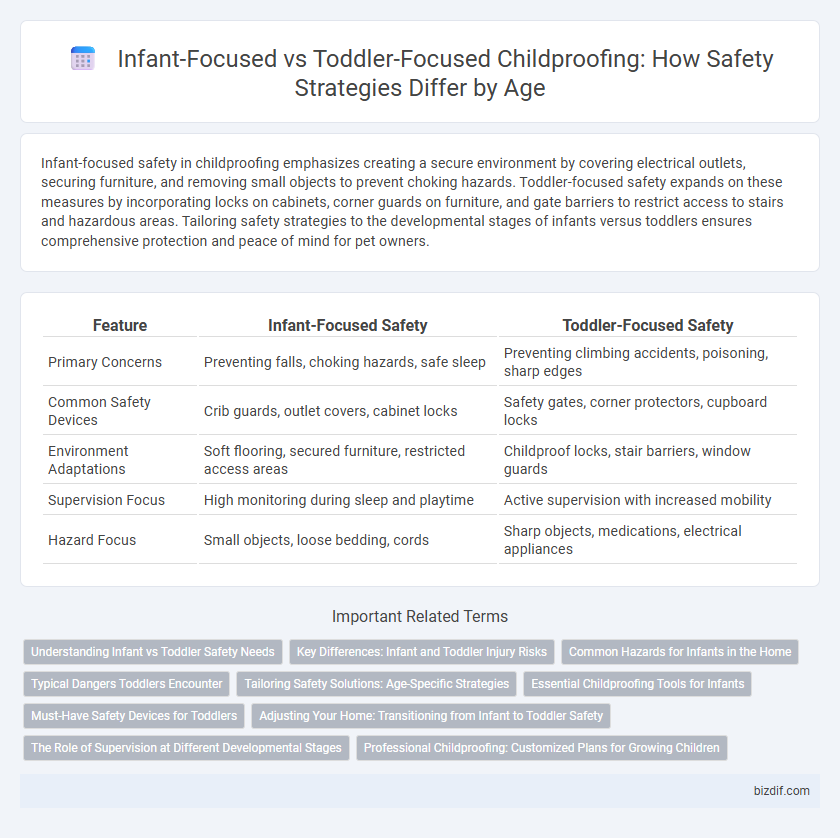Infant-focused safety in childproofing emphasizes creating a secure environment by covering electrical outlets, securing furniture, and removing small objects to prevent choking hazards. Toddler-focused safety expands on these measures by incorporating locks on cabinets, corner guards on furniture, and gate barriers to restrict access to stairs and hazardous areas. Tailoring safety strategies to the developmental stages of infants versus toddlers ensures comprehensive protection and peace of mind for pet owners.
Table of Comparison
| Feature | Infant-Focused Safety | Toddler-Focused Safety |
|---|---|---|
| Primary Concerns | Preventing falls, choking hazards, safe sleep | Preventing climbing accidents, poisoning, sharp edges |
| Common Safety Devices | Crib guards, outlet covers, cabinet locks | Safety gates, corner protectors, cupboard locks |
| Environment Adaptations | Soft flooring, secured furniture, restricted access areas | Childproof locks, stair barriers, window guards |
| Supervision Focus | High monitoring during sleep and playtime | Active supervision with increased mobility |
| Hazard Focus | Small objects, loose bedding, cords | Sharp objects, medications, electrical appliances |
Understanding Infant vs Toddler Safety Needs
Understanding infant safety needs involves securing cribs, electrical outlets, and choking hazards, as infants are immobile but prone to exploring objects orally. Toddler safety focuses on preventing falls, managing furniture edges, and securing cabinets due to increased mobility, climbing, and curiosity. Tailoring childproofing services to these developmental stages ensures effective risk reduction and a safer home environment.
Key Differences: Infant and Toddler Injury Risks
Infant-focused safety primarily targets risks such as choking hazards, suffocation, and falls from sleeping surfaces, emphasizing crib safety and secure sleep environments. Toddler-focused safety addresses increased mobility-related dangers including climbing falls, ingestion of small objects, and access to sharp or toxic items. Understanding these distinctions guides tailored childproofing strategies that effectively mitigate age-specific injury risks.
Common Hazards for Infants in the Home
Common hazards for infants in the home include choking risks from small objects, unsecured furniture that can tip over, and accessible electrical outlets. Infant-focused safety emphasizes securing cords, installing outlet covers, and ensuring soft bedding to reduce suffocation risks. Unlike toddlers, infants require protection from immobility-related dangers such as sharp corners and hazardous substances within reach.
Typical Dangers Toddlers Encounter
Toddler-focused safety addresses typical dangers such as sharp furniture edges, accessible electrical outlets, small objects posing choking hazards, and staircases without gates. Unlike infants, toddlers are more mobile and curious, increasing risks of falls, poisoning from household chemicals, and injury from tipping heavy furniture. Effective childproofing strategies for toddlers prioritize securing these hazards to create a safer environment during their exploratory phase.
Tailoring Safety Solutions: Age-Specific Strategies
Tailoring childproofing solutions requires focusing on infant-specific hazards such as choking risks, sharp edges, and electrical outlets, while toddler safety needs address mobility-related dangers like climbing, sharp corners, and accessible toxic substances. Effective strategies integrate age-specific interventions including outlet covers and corner guards for infants, and secure locks, gates, and window guards for toddlers. Customizing safety measures based on developmental milestones ensures comprehensive protection in the home environment.
Essential Childproofing Tools for Infants
Essential childproofing tools for infants include outlet covers, cabinet locks, and corner protectors that prevent access to electrical hazards and sharp edges. Soft gate barriers are vital to restrict movement to unsafe areas, while secure crib rail guards ensure sleeping safety. These infant-specific safety devices focus on minimizing choking risks and protecting delicate skin to create a secure environment for early development.
Must-Have Safety Devices for Toddlers
Toddler-focused safety devices prioritize securing cabinets with childproof locks, installing stair gates to prevent falls, and using outlet covers to avoid electrical hazards. Rounded corner protectors on furniture and window guards are essential to minimize injury risks as toddlers explore their environment. Emphasizing these must-have devices ensures a safer home tailored to the active and curious nature of toddlers.
Adjusting Your Home: Transitioning from Infant to Toddler Safety
Adjusting your home for toddler safety involves upgrading infant-proof measures to address increased mobility and curiosity, such as installing higher cabinet locks and securing heavier furniture to walls. Toddlers require safer access points and more robust barriers around hazards like stairs and electrical outlets, reflecting their developing motor skills compared to infants. Transitioning from infant to toddler safety means regularly reassessing and enhancing childproofing devices to create a secure environment tailored to a toddler's growing independence.
The Role of Supervision at Different Developmental Stages
Infant-focused safety emphasizes creating a secure environment by eliminating choking hazards and securing furniture, while toddler-focused safety involves managing increased mobility and curiosity with gated areas and corner protectors. Supervision plays a critical role, requiring constant vigilance during infancy as babies explore through touch and mouth, transitioning to active monitoring as toddlers begin climbing and experimenting. Tailoring supervision strategies to these developmental stages significantly reduces accident risks and enhances overall childproofing effectiveness.
Professional Childproofing: Customized Plans for Growing Children
Professional childproofing services tailor safety plans that evolve with a child's developmental stages, focusing on infant-specific hazards like crib safety and outlet covers before addressing toddler risks such as securing furniture and installing safety gates. Customized strategies incorporate expert assessments of home environments to mitigate age-appropriate dangers, enhancing protection as children transition from immobility to active exploration. These targeted interventions significantly reduce accidents by adapting safety measures to fit the unique needs of infants and toddlers.
Infant-Focused Safety vs Toddler-Focused Safety Infographic

 bizdif.com
bizdif.com